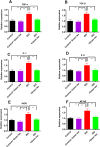Camellia sinensis powder rich in epicatechin and polyphenols attenuates isoprenaline induced cardiac injury by activating the Nrf2 HO1 antioxidant pathway in rats
- PMID: 40596364
- PMCID: PMC12214831
- DOI: 10.1038/s41598-025-08720-w
Camellia sinensis powder rich in epicatechin and polyphenols attenuates isoprenaline induced cardiac injury by activating the Nrf2 HO1 antioxidant pathway in rats
Abstract
Myocardial infarction is a leading cause of death and morbidity in individuals with cardiovascular diseases. Natural antioxidants, such as those found in green tea leaves, are beneficial in preventing these diseases. This study evaluated the protective effects of green tea leaves powder against isoprenaline (ISO)-induced myocardial infarction in rats. Four groups of male Long Evans rats were used: Control, Control + green tea leaves powder, ISO, and ISO + green tea leaves powder. Organ and blood plasma samples were collected to measure oxidative stress biomarkers, biochemical parameters, and gene expressions. Furthermore, tissue sections were prepared and stained histologically. ISO-induced rats showed decreased cellular antioxidants (catalase activity and glutathione concentration) and elevated oxidative stress markers. Notable inflammatory cell infiltration and fibrosis were observed in the heart and kidneys of ISO-induced rats. Supplementation with green tea leaves powder significantly restored catalase activity and glutathione concentration (p < 0.05) in plasma and tissues. It also considerably reduced lipid peroxidation, nitric oxide, and advanced oxidation protein products (p < 0.05) in ISO-administered rats. Furthermore, green tea leaves powder supplementation halted inflammatory gene expression (p < 0.05), restored antioxidant genes (p < 0.05) such as Nrf-2-HO-1, and prevented cardiac fibrosis in ISO-administered rats. Green tea leaves powder supplementation may reduce oxidative stress, inflammation, and fibrosis in ISO-administered rats, potentially through the Nrf-2-HO-1-mediated restoration of antioxidant enzymes and prevention of heart inflammation.
Keywords: Camellia sinensis; Fibrosis; Inflammation; Isoprenaline; Myocardial infarction.
© 2025. The Author(s).
Conflict of interest statement
Declarations. Competing interests: The authors declare no competing interests.
Figures
















Similar articles
-
Neuroprotective role of oleuropein in post-myocardial infarction rats: targeting antioxidant, anti-inflammatory, and anti-apoptotic mechanisms.Eur J Pharmacol. 2025 Sep 15;1003:177936. doi: 10.1016/j.ejphar.2025.177936. Epub 2025 Jul 10. Eur J Pharmacol. 2025. PMID: 40651794
-
Nano Astaxanthin ameliorates myocardial infarction in rats through autophagy.Sci Rep. 2025 Jun 20;15(1):20195. doi: 10.1038/s41598-025-06206-3. Sci Rep. 2025. PMID: 40542058 Free PMC article.
-
Pelargonidin-3-O-glucoside prevents isoproterenol-induced myocardial infarction via modulating cardiac and inflammatory markers expression in experimental rats.Hum Exp Toxicol. 2025 Jan-Dec;44:9603271251369054. doi: 10.1177/09603271251369054. Epub 2025 Aug 22. Hum Exp Toxicol. 2025. PMID: 40842346
-
Green tea (Camellia sinensis) for the prevention of cancer.Cochrane Database Syst Rev. 2009 Jul 8;2009(3):CD005004. doi: 10.1002/14651858.CD005004.pub2. Cochrane Database Syst Rev. 2009. Update in: Cochrane Database Syst Rev. 2020 Mar 2;3:CD005004. doi: 10.1002/14651858.CD005004.pub3. PMID: 19588362 Free PMC article. Updated.
-
Catechins and Human Health: Breakthroughs from Clinical Trials.Molecules. 2025 Jul 25;30(15):3128. doi: 10.3390/molecules30153128. Molecules. 2025. PMID: 40807299 Free PMC article. Review.
References
-
- Chong, B. et al. Global burden of cardiovascular diseases: Projections from 2025 to 2050. Eur. J. Prev. Cardiol.10.1093/eurjpc/zwae281 (2024). - PubMed
-
- Mocumbi, A. O. Cardiovascular health care in low- and middle-income countries. Circulation149, 557–559. 10.1161/CIRCULATIONAHA.123.065717 (2024). - PubMed
-
- Sliwa, K. et al. Cardiovascular disease in low- and middle-income countries associated with environmental factors. Eur. J. Prev. Cardiol.31, 688–697. 10.1093/eurjpc/zwad388 (2024). - PubMed
-
- Kumar, A. et al. The canadian cardiovascular society classification of acute atherothrombotic myocardial infarction based on stages of tissue injury severity: An expert consensus statement. Can. J. Cardiol.40, 1–14. 10.1016/j.cjca.2023.09.020 (2024). - PubMed
MeSH terms
Substances
LinkOut - more resources
Full Text Sources
Medical

